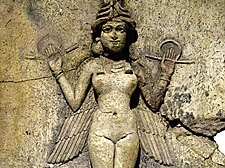|
|
 |
| |

The Queen of the Night, an ancient Babylonian depiction of the goddess Isis, at the British Museum |
God is love – but killing still goes on in his name
IN my opinion the greatest danger to today’s world comes from fundamentalists in all religions and creeds, combined with nationalism. Journalist John Pilger describes how this combination has caused wars, civil wars, dictatorships, genocide and terrorism all over the world including Iraq, Afghanistan, Lebanon and Israel.
From time immemorial, human beings, never able to tolerate mysteries, have been driven to seek certainty, answers, something to believe in, personifying phenomena we do not understand as ‘goddesses’ and ‘gods’. Hence, worshipping gods of rain and thunder and all the mysteries of nature gave birth to religions.
Every culture has religions and rituals, typified by the story of a man from Africa visiting England invited to observe something called ‘cricket’. Back home he described it. “The English have their rituals. In the main one, priests in white garments proceed onto a field carrying sticks of wood. One plants these in the ground. Another comes bearing a red orb and passes it to a third. Then the rain comes down”.
Rain, of course, especially in hot dry deserts, is the most important element we pray for, with rituals too numerous to mention. The most extreme, found at different times in disparate religions, is human sacrifice. A progression is seen from human, through animal and inanimate objects, to spiritual sacrifice. In Western religions, the Old Testament recounts the transition from human to animal sacrifice in the story recounting God’s willingness to accept the sacrifice of a ram in place of Abraham’s beloved son Isaac.
This acceptance seems to be characteristic of monotheism. God wants only “a contrite heart, penitence, charity”. These teachings of Isaiah inspired Jesus at times when there were divisions within Judaism. However, the Old Testament also describes how, when their monotheistic beliefs were challenged, the Israelites reverted to worshipping the golden calf. It was hard to shift people from this practice. Some will worship anything rather than accept that unsolved mysteries exist.
The Old Testament, a series of stories, covers thousands of years and this theological progression. The New Testament and the Quran cover much briefer periods and take that idea of a single God for granted.
Before the advent of monotheism, goddesses reigned for millions of years, combining destruction and preservation. They embraced gods, animals, and nature. When the Israelites conquered a territory the first thing they did was tear down statues to the goddesses and trees. The golden calf was actually Hathor, Egyptian Goddess of love, music and beauty but also of destruction. Her beautiful temple is at Dendera in Egypt.
People started to worship gods, play things who came with war and horses as weapons. They assumed different personages for sex and in different forms could rape.
In the story of Leda, the swan-seducer was the god Zeus in one of his many disguises. Inanna, goddess of love, fertility and war, embraced her father, son, lover and all the animals and birds. I feel the recent British Museum acquisition, who has been called ‘The Queen of the Night’ symbolises Inanna, also known as Ishtar, Isis and Astarti. The Song of Solomon, one of the most beautiful biblical texts, was taken from Inanna’s love songs, which exemplify mutual adoration of male and female bodies. This embodiment of male-female, positive-negative, links into Eastern philosophies with their concept of balance.
To me it seems a fault, especially in matters of faith, that the human mind can embrace contradictory beliefs simultaneously. Most religions worship the ‘God of love and forgiveness’ and pay lip service to the commandment, “Thou shalt not kill”, while believing that God tells them to kill those who do not agree with them – killing to defend ‘certainty’.
Every religion is divided into sects, each claiming “God is on our side” and “the others” are “forces of evil to be destroyed”, as US President George Bush puts it. Even highly intelligent people, can hold two opposing beliefs and kill in the name of God who is “on everybody’s side”.
Some fundamentalists believe in killing people but saving animals. Others oppose abortion, which they describe as ‘killing’, so strongly that they believe in killing as punishment for abortionists. George Bush when he was Governor of Texas showed no qualms about killing people as punishment for crimes, even when they are shown not to have the mental capacity to understand their crimes, but absolutely opposes killing of foetuses.
Fortunately there are and always have been people with religious beliefs and without, who believe in love and refuse to kill. They tend to be those imbued with a strong sense of curiosity, who accept the existence of unexplained mysteries in what science now recognises as the microcosm and the macrocosm. Advances in atomic and quantum theories show they are all part of the same mystery.
We cannot stand mysteries yet scientists’ attempts to unravel them deepen those very mysteries. With new sophisticated instruments, scientists now know that observation itself and scientific instruments change the objects observed unpredictably, suggesting that cosmological mysteries can never be solved.
It is the claim of certainty and the fundamentalism that claim can spawn, with all its resultant killings, that is the real danger.
|
 |
| |
|
 |
|